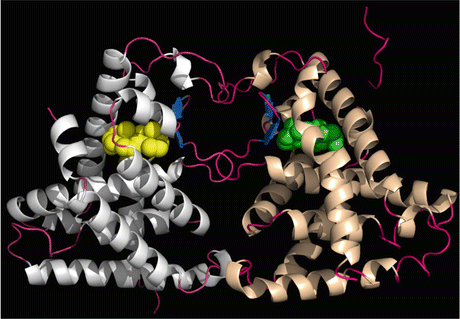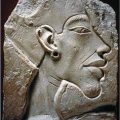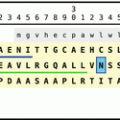and Winfried G. Rossmanith2
(1)
Lenzkirch, Germany
(2)
Ettlingen, Germany
Hormone receptors belong mainly to two large receptor groups: heptahelical G-protein-coupled membrane receptors and cytosolic nuclear receptors for steroids and thyroid hormones. The exceptions are particularly the insulin and the growth hormone receptors
The signals initiated by the main receptor groups have characteristic differences:
Fast-acting receptor signals. G-protein-coupled receptors (GPCR s) trigger immediate reactions which are converted into long-lasting regulations by other intracellular interaction partners. Ion channel openings, membrane depolarization , release of calcium from intracellular calcium stores , activation of kinase s, and lipid conversions by phospholipases are influenced by GPCRs. These reactions occur within seconds or faster. If these immediate reactions are transduced into the cellular nucleus and genes are activated, long-lasting modifications can occur.
Slow, genomic changes. Cytosolic receptors for steroids or the thyroid hormones do not trigger immediate reactions. Hormones which have reached the cytosol by diffusion through the cell membrane initiate hormone receptor dimerization . By this dimerization, a nuclear import signal for the entire complex is generated. After transfer to the cellular nucleus, the dimer associates with characteristic recognition motifs on the DNA. Such an interaction modulates the activity of the associated gene, either activation of transcription or its inhibition. Whereas GPCRs trigger fast signal cascades at the membrane, nuclear receptors act in the cellular nucleus and modify gene activities. These reactions take longer than seconds: they need minutes or hours.
8.1 Nuclear Receptors
In 2004, the Lasker Award was given to three biochemists: Elwood Jensen , Ronald Evans , and Pierre Chambon . They had presented evidence for receptors which are today called nuclear receptors and studied their features (see Fig. 8.1). Forty-eight human nuclear receptors have been identified which recognize steroids, thyroxine, triiodothyronine, vitamin D3, and vitamin A (Table 8.1). In the liver, many of these nuclear receptors target drugs and poisons.


Fig. 8.1
Model of a nuclear receptor: The murine androstane receptor. Androstane (yellow spheres and green spheres) is embedded into the receptor structure, which consists mainly of helices and a single β sheet (blue). Two receptor molecules adhere at the side with the β sheet. This generates the nuclear import signal. The dimer is imported into the cellular nucleus; by binding to recognition motifs, it modulates gene activity (Produced with PyMOL using Protein Data Bank entry 1XNX)
Table 8.1
Nuclear receptors
Hormone/ligand | Receptor | Type | OMIM entries |
|---|---|---|---|
Thyroid hormone | ErbA (TR) | α, β | 190120, 190160 |
Estrogen | ER | α, β | 133430, 601663 |
Progesterone | PR | 607311 | |
Testosterone, DHT | AR | 133700 | |
Mineralocorticoid | MR (NR3C2) | α, β | 600983 |
Glucocorticoid | GR | 138040 | |
Vitamin D | VDR | 601769 | |
All-trans-retinoic acid | RAR | α, β, γ | 180240, 180220, 180190 |
9-cis-Retinoic acid | RXR | α, β, γ | 180245, 180246, 180247 |
Oxysterol | LXR | α, β | 602423, 600380 |
Bile acids | FXR | 603826 | |
Fatty acids | PPAR | α, γ, δ | 170998, 601487, 600409 |
Pregnanes, xenobiotics | PXR (NR1I2) | 603065 | |
Xenobiotics | CAR | 603881 |
There are three characteristic features of each nuclear receptor:
1.
Ligand binding. All nuclear receptors have a domain where the ligand is accepted—for example, the hormone, the vitamin, or the toxin.
2.
Dimerization. After ligand binding, two ligand-bound receptors form a dimer.
3.
DNA binding. The dimerization of two nuclear receptors creates a nuclear import signal. This signal triggers transport of the dimer into the cellular nucleus and allows the dimer to bind to its recognition sites. Any functional nuclear receptor has its own recognition sites. After binding of the dimer to the DNA, gene activity in that chromosomal region is modulated. The transcriptional activity might be enhanced or reduced. This will eventually stimulate or suppress cellular functions.
8.2 Heptahelical Transmembrane Receptors
In contrast to steroids, which dock to intracellular nuclear receptors, peptide/protein hormones bind to receptors on the surface of cells. Most of these receptors belong to a protein family where the membrane is spanned sevenfold (“seven” is hepta in Greek) by helices, so-called heptahelical receptors (Tables 8.2 and 8.3, Fig. 8.2).
Table 8.2
Class A heptahelical receptors: receptors related to rhodopsin and β-adrenergic receptor
Hormone/ligand | Receptor | Subtypes | OMIM entries |
|---|---|---|---|
Adenosine | Adenosine receptor | A1, A2a, A2b, A3 | 102775, 102776, 600446, 600445 |
MSH, ACTH | MC1-R (MSH-R in melanocytes), MC2-R (ACTH-R in the adrenal cortex), MC3-R (in the CNS), MC4-R (AgRP in the hypothalamus), MC5-R (in exocrine glands) | 155555, 202200, 155540, 155541, 600042 | |
Noradrenaline, adrenaline | α-Adrenergic receptors | 1A, 1B, 1D | 104221, 104220, 104219 |
2A, 2B, 2C | 104210, 104260, 104250 | ||
β-Adrenergic receptors | 1, 2, 3 | 109630, 109690, 109691 | |
Dopamine | DPR | 1a, 1b, 2 | 126449, 126453, 126450 |
Serotonin (5-hydroxytryptamine) | HTR | 1a, 1b, 1d, 1e, 1f | 109760, 182131, 182133, 182132, 182134 |
2a, 2b, 2c | 182135, 601122, 312861 | ||
3a, 3b, 5a, 6, 7 | 182139, 604654, 601305, 601109, 182137 | ||
Acetylcholine | Muscarinic AChRa | 1, 2, 3, 4, 5 | 118510, 118493, 118494, 118495, 118496 |
Angiotensin II | AGTR | 1, 2 | 106165, 300034 |
Bradykinin | BDKR | B1, B2 | 600337, 113503 |
Bombesin | BRS3 | 300107 | |
Gastrin-releasing peptide | GRPR | 305670 | |
Cholecystokinin | CCK-R | A, B | 119444, 119445 |
Neuromedin B | NMBR | 162341 | |
Neuromedin U | NMUR | 1, 2 | 604153, 605108 |
Neuropeptide Y | NPYR | 1, 2, (3)b, 5 | 162641, 162642, (162643), 602001 |
Oxytocin | OXTR | 167055 | |
Arginine vasopressin | AVPR | 1a, 1b | 600821, 600264 |
Galanin | GALR | 1, 2, 3 | 600377, 603691, 603692 |
Somatostatin | SSTR | 1, 2, 3, 4, 5 | 182451, 182452, 182453, 182454, 182455 |
GnRH | GnRHR | 138850 | |
TRH | TRHR | 188545 | |
Melatonin | MTNR | 1a, 1b | 600665, 600804 |
FSH | FSHR | 136435 | |
LH/hCG | LHCGR | 152790 | |
TSH | TSHR | 603372 |






